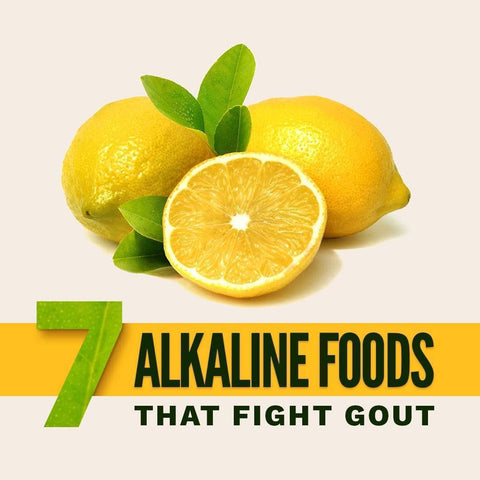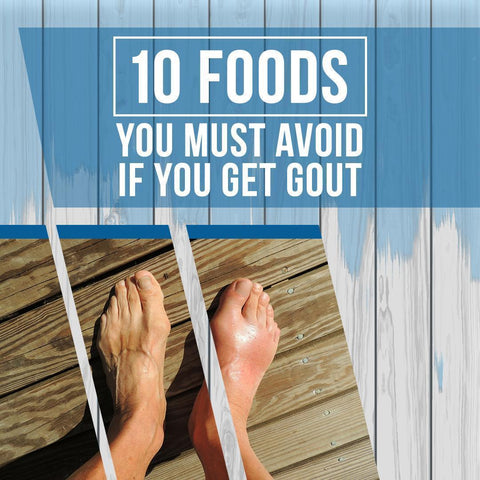
Let’s get to the bottom of gout. You’ve probably heard about it or have had it, and that’s why you’re reading this.
This article will give you the most important facts about the disease: what it is, how it's typically treated, and how to naturally relieve the suffering it causes.
What is Gout? What Causes it?
Gout is a painful arthritic condition that causes soreness, pain, and redness in joints. The pain can be sudden and severe. Sometimes, sufferers wake up in the middle of the night with sensations like their joints are on fire.
The suffering that gout triggers is caused by the buildup of uric acid in joints (tissues that connect bones together).
The suffering that gout triggers is caused by the buildup of uric acid in joints (tissues that connect bones together).
There is normally some uric acid that comes out through your urine and is a normal metabolic byproduct of purine, a component in a variety of foods but mainly animal products. But if you’re consuming more than your body can handle, excess amounts of this acid crystallizes in joints resulting in pain and discomfort caused by the inflammation.
It’s recommended that you see a doctor if you experience sudden intense pain in your joints because gout can lead to even worse pain and damage to the joints.
How to Know if You Have Gout
There are certain lifestyle factors that indicate your likelihood of developing gout. We will talk about those in a bit.
First, let’s look at some general symptoms of gout:
- Joint pain
- Inflammation and redness around joint area
- Decreased range of motion
- Lasting discomfort after pain lessens

Typical Mainstream Medical Treatments for Gout
Many pharmaceutical medications can be used to treat gout. Typical drugs are NSAIDs like ibuprofen, other anti-inflammatory drugs, and drugs that block uric acid production in the body.
Though, of course, powerful anti-gout drugs can come with a list of nasty possible side effects like nausea, mood disturbances, vomiting, and reduced liver function.
Take, for instance, the drug Colcrys, which has been FDA-approved for the treatment of gout. Possible side effects include diarrhea, nausea, cramping, stomach or abdominal pain, and vomiting.
The bottom line, as you will see, is that uric acid buildup can be most effectively reduced by lifestyle choices and natural remedies.
Exclusive Bonus! Download the FREE report ‘12 Top Ways to Fight Gout & Ease The Pain’ by clicking here.
Why Do People Develop Gout?
Your diet largely determines whether you develop gout or not. What you eat and drink directly affects how much uric acid is in your body and whether uric acid builds up in your joints.2.
Your diet largely determines whether you develop gout or not. What you eat and drink directly affects how much uric acid is in your body and whether uric acid builds up in your joints.
In large part, sticking to plant-based foods like vegetables, nuts, seeds, whole grains, and fruit minimizes your risk of gout. Meat is especially high in purines, the precursors to uric acid.
Here are some lifestyle factors that increase your risk of gout:
1.Excessive Alcohol Consumption

Beer and spirits are linked to gout 1. People have long noticed the correlation between boozing it up and gout attacks. Overindulging in alcohol is not healthy, for sure!
Alcohol causes sharp increases in uric acid. But there’s good news in all of this. Moderate wine consumption does not appear to increase the risk of gout, unlike other types of alcohol 12.
2.You Eat a Lot of Meat
Animal flesh is full of purines which your body converts into uric acid. If your diet is centered around meat, or if you are consuming it in excess, you will be at a higher risk of developing gout.
In past centuries, gout was known as “the disease of kings” or a disease of the rich due to the huge amounts of meat and alcohol that were consumed by the upper classes.
3.You Eat a Lot of Seafood

Some people distinguish between land meats and meats that come from the sea. But make no mistake – seafood increases your risk of gout just as other meats do.
Many types of fish and shellfish are especially high in purines. Anchovies, scallops, herring, and sardines are just a few examples of food from the sea with very high levels of purine. Research has clearly shown that seafood is correlated with a higher risk of gout 3.
4.You Are Obese or Have Type II Diabetes
Though gout doesn’t occur directly as a result of diabetes, researchers have found that your chances of developing gout are greatly increased if you have type II diabetes 4.
Type II diabetes is largely caused by overeating, which leads to insulin resistance and high blood sugar levels. It makes sense that the two are connected because if you’re eating way too much in general, chances are that you’re consuming more purines than is good for you, and you will have more uric acid in your body.
5. You Drink a Lot of Soft Drinks

They contribute to diabetes, metabolic syndrome, obesity, and can play a role in liver disease.
Fructose-heavy drinks are also “strongly associated” with gout in men 5. Unfortunately, the reason for the fructose-gout connection is still unclear 6. But considering that fructose-rich beverages are associated with gout in women as well, you can be fairly certain that fructose contributes to gout 7.
Natural Remedies for Gout
- Abstaining from the bad stuff detailed above is an incredibly powerful way to stop uric acid buildup.
- There are also various natural compounds and foods that specifically help fight the symptoms of gout as well as uric acid buildup.
-
If you take the right remedial preparations and eat the right foods, you can further alleviate your gout suffering.
Click here to see the foods and natural remedies that alleviate gout symptoms.
Gout: Frequently Asked Questions
1.Is diet the only determining factor for developing gout?

To be certain, the food that you eat plays a huge role in how much uric acid builds up in your body.
But there are two other variables that contribute to uric acid buildup. One is the amount of uric acid that your body generates, which is not under your control (so we will not pay much attention to it here).
The other variable is the health of your kidneys. These organs are responsible for processing and readying uric acid for excretion. If you’re kidneys are damaged or unhealthy, they may not be able to process uric acid efficiently. Diabetics often have damaged kidneys, so it’s no wonder they tend to have higher uric acid levels.
2.How is gout diagnosed?
Uric acid levels are typically high in the body over a period of time before uric acid crystals form in the joints. Once symptoms develop in the affected joints, doctors can stick a needle into your joint to draw fluid. If the fluid is high in uric acid, this is an indication of gout.
Ultrasounds or X-rays can also indicate to doctors that uric acid crystals have formed in joints.
3.Where (what part of the body) do people feel gout symptoms?

Gout sufferers often have pain in their feet, often the big toe, because there are so many joints in the feet. Pain may also be felt in the hands, knees, ankles, and other joints.
4. How long does gout last?
Chronic gout can last indefinitely if a person does not take steps to reduce uric acid crystalization. That’s why it’s so important to eat the right foods and take advantage of natural remedies.
Take Action!
Now that you know this information, take steps to ease your gout suffering! Cut meat, alcohol, and high-fructose soft drinks out of your diet and start consuming the specific foods and herbs that fight uric acid buildup.
Here’s the link one more time to the foods and herbs that will end your gout suffering.









